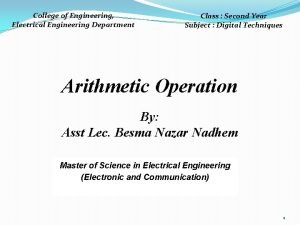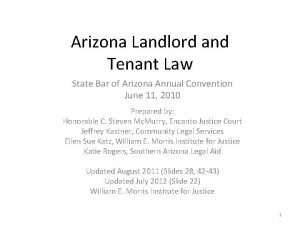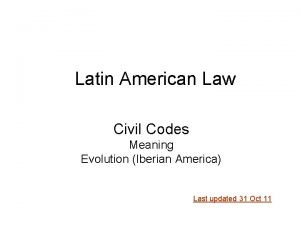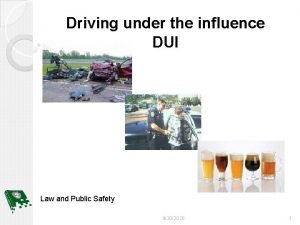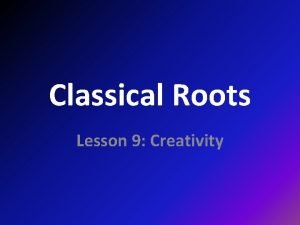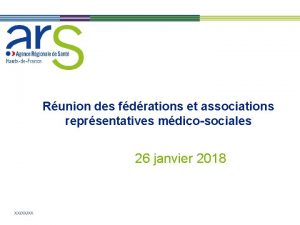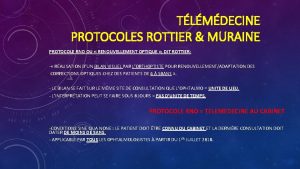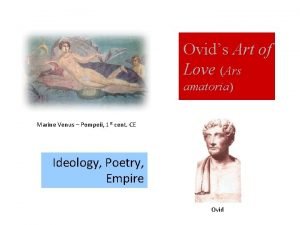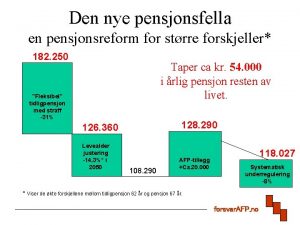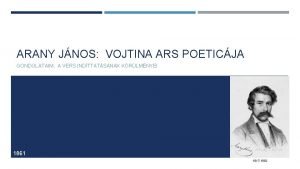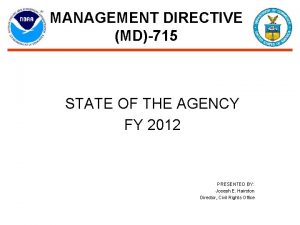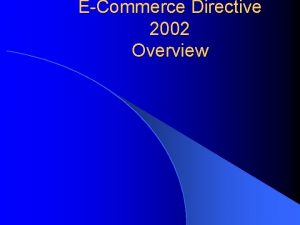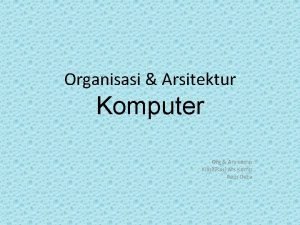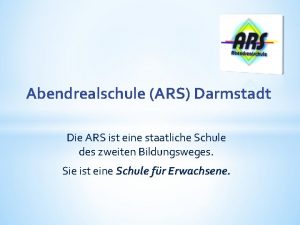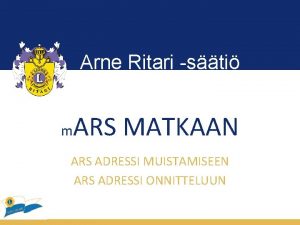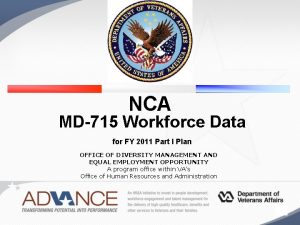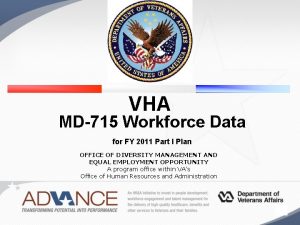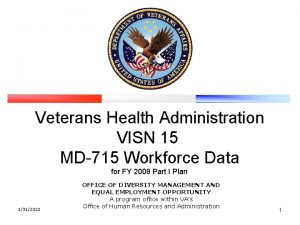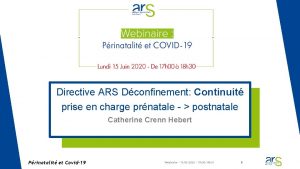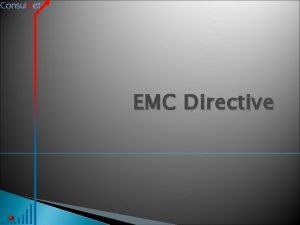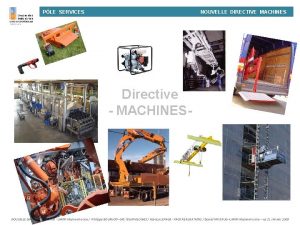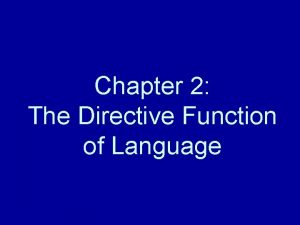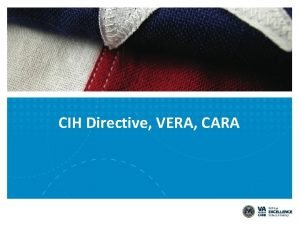MANAGEMENT DIRECTIVE 715 MD715 Overview ARS Office of

































- Slides: 33

MANAGEMENT DIRECTIVE 715 (MD-715) Overview ARS, Office of Outreach, Diversity, and Equal Opportunity (ODEO)

Objectives • Provide definition and importance of the MD-715. • Explain what a barrier is. • Provide suggestions on how to utilize the MD-715 in the recruitment process and to eliminate barriers preventing a diverse workforce.

What is the MD-715? MD-715 provides policy guidance and standards on developing and measuring effectiveness of affirmative employment programs.

What is the MD-715? MD-715 provides a “living” roadmap for agencies to plan, implement, and measure their success in providing equal opportunity for applicants and employees.

What is the MD-715? The MD-715 also provides a summary of challenges that the agency faces in attaining the status of a model EEO employer.

What is MD-715? MD-715 provides the opportunity to demonstrate accomplishments in civil rights, EEO and diversity realms.

Six Elements to Assist ARS Per EEOC, there are 6 elements to assist agencies to have model EEO programs • Demonstrated commitment from agency leadership • Integration of EEO into the agency’s strategic mission • Management and program accountability • Proactive prevention of unlawful discrimination • Efficiency • Responsiveness and legal compliance

Element 1 – Demonstrated Commitment From Agency Leadership • Equal employment opportunity must be: • Embraced by the agency leadership • Communicated through the ranks from the top down • EEO principles must be made a fundamental part of the agency’s culture. • Agency head must issue annual EEO/CR and antiharassment policy statements enforcing that the agency has zero tolerance for discrimination. • Managers must ensure that all EEO/CR polices and mandatory posters are visible to all that enter the Locations/Areas.

Element 2 – Integration of EEO into the Agency’s Strategic Mission • Chief EEO person (ODEO Director): • Reports directly to the Agency head and has access to all senior leaders • Is involved with Human Resources issues. • Has sufficient resources (budgetary and personnel) to manage the Title VII (federal employment) and Rehabilitation Act programs • Communicates best practices in EEO/Civil Rights/Diversity to Agency employees.

Element 3 – Management and Program Accountability • Area ODEO Program Managers should communicate to managers/supervisors the status of Area EEO programs. • Mangers at all levels are held accountable for effective implementation of the EEO program enforcing the policies preventing discrimination, harassment, and retaliation. • HR and EEO Directors should meet regularly to assess programs, policies, and procedures. • Managers will be evaluated on efforts to ensure equal opportunity for employees.

Element 4 – Proactive Prevention of Unlawful Discrimination Agencies have an on-going obligation to prevent discrimination on: Race, color, national origin, age, disability, sex, gender identity, religion, reprisal, political beliefs, marital status, familial or parental status, sexual orientation, or where all or part of an individual’s income is derived from any public assistance program, or protected genetic information in employment or in any program or activity conducted or funded by USDA.

Element 4 – Proactive Prevention of Unlawful Discrimination (continued) • Agencies must conduct an annual self-assessment (diagnostic tool, not a report card) to monitor progress of the EEO program and identify barriers preventing equal opportunity. • Develop realistic action plans to eliminate/reduce the identified barriers preventing equal opportunity (assign specific responsibilities and due dates (not on-going)].

Element 5 - Efficiency Agencies must have: • Sufficient staffing, funding, and authority to achieve the elimination of identified barriers. • Sufficient staffing, funding, and authority to comply with time frames in accordance with the EEOC regs for processing EEO complaints. • Fair and efficient dispute resolution process including the participation of managers. • Track demographic information on employees by race/ethnicity, gender, and disabilities.

Element 6 – Responsiveness and Legal Compliance • Agencies must demonstrate full compliance with EEOC regulations, federal law and other directives. • Annual reports are prepared responding to EEOC orders and directives. • Ensure that ARS fully complies with EEOC orders for corrective actions of identified barriers.

What is a Barrier? • A policy, procedure, practice or condition that limits employment opportunities for members of a particular race, ethnic background or gender, or because of a disability. • Some barriers may be easy to identify. • Other barriers are embedded in the day-to-day procedures and practices and may appear neutral.

What is Barrier Analysis? • A barrier analysis is an investigation. • The subject of the investigation is the trigger/red flag (trend or disparity in workforce statistics, complaint data, etc. , that suggest the need for an inquiry into an employment policy, principle, practice, procedure or condition). • The outcome of the investigation should be the root cause of the trigger/red flag. • This root cause may or may not be a barrier.

Barrier Identification & Elimination Identify where barriers may exist using various source information (workforce statistics, EEO complaints, etc. ).

Barriers might be found in: • Recruitment • Hiring • Competitive and career-ladder promotions • Training and development • Awards and incentives programs • Disciplinary Actions • Separations

Institutional or Structural Barriers Examples: • Recruitment: Excessive reliance on a computerized or electronic application process. • Policy/Procedure: Inadequately enforced anti or sexual harassment policies. • Hiring: Agency will hire only at higher grades, as opposed to hiring at the entry level.

Attitudinal Barriers Examples: • Recruitment, Hiring, Promotions, Training and Develop: Senior executives belief that women will not be as committed to the agency’s mission after having a child. • Hiring: Evaluation panel’s stereotypical or unconscious biases or selection criteria screens out a particular racial, national, cultural, or gender group.

Physical Barriers Examples: • Improper Implementation of Reasonable Accommodation Policy/Procedure: Restroom doors only open half-way, making restrooms inaccessible to employees who use wheelchairs. • Workplace/Facility: The physical structure and layout of the facility is not in compliance with applicable accessibility standards.

More Examples of Barriers: • Too much discretion given to recruiters. • Excessive reliance on a computerized or electronic application process. • Stereotypical attitudes about particular groups on the part of those who serve on selection panels. • Widespread failure to properly implement policies or reasonable accommodation procedures.

Barrier Identification & Elimination Investigate to pinpoint actual barriers and their root causes by developing a list of individuals to be interviewed based on the information gathered from the review of workforce statistics, complaints, and other sources; and formulate questions to ask during interviews and determine what answers are needed.

Barrier Analysis Investigation Documents to be reviewed include, but are not limited to: • Agency policies • Organization/function/staffing charts • Funding & resource documentation • Worktables – hiring, promotions, disciplinary actions, etc. • Plans and mission statements • Data – statistics and other computations • Any additional documents referred to in interviews or otherwise pertinent inquiries and conversations • Agency accomplishments

Barrier Analysis Investigation How much information is enough? • A drill-down process. • Keep asking “why” until you have a testable answer (treat the root cause, not the symptom). • Key: The identification of a barrier is always a working hypothesis. • The barrier identification should be detailed enough to be tested through the development and implementation of an action plan.

Barrier Identification & Elimination • Develop and implement a realistic action plan to eliminate barriers. • Assess success of plan’s implementation, which will be determined in your annual reports. • Determine if plan needs to be adjusted because of additional barriers. NOTE: Area Program Manager has the format of the plans mandated by EEOC (Parts I and J). For more information to understand barriers, visit http: //www. eeoc. gov/federal/directives/715 instruct/section 2. html

Myths about MD-715: Myth: The MD-715 is an annual report. Reality: The MD-715 is a management tool to be used throughout the year - not just an annual report. It is a “living” document. Recommended for Program Manager and senior management to discuss action plan status quarterly. MD-715 is not an ODEO or ARS requirement. It is mandated by the Equal Employment Opportunity Commission (EEOC). The Administrator is held accountable by Agency reports on her/his EEO performance standard. Once the Program Manager conducts the analysis of the workforce data and determines the barriers to improve workforce diversity, it should be a team effort to prepare action plans to eliminate the barriers.

Myths about MD-715: Myth: The Area ODEO Program Manager is responsible for the MD 715. Reality: The ODEO Program Manager, HR, and management all play a part. Myth: The MD-715 is all about workforce data and comparing it to the Civilian Labor Force (CLF). Reality: The data is interpreted to see where the barriers are. It’s much more than being above or below the CLF.

What can you as a manager do? • Familiarize yourself and assist in completion of the Self-Assessment (http: //www. eeoc. gov/federal/directives/715 instruct/section 1. html) • Familiarize yourself with MD-715 worktables (http: //www. eeoc. gov/federal/directives/715 instruct/tables. html) • Provide: • • • Equal access to job opportunities Equal opportunity for job success No disparate treatment No unlawful disparate impact Proactive prevention

How to Use the MD-715 Recruitment Planning: Appendix A of the REE Recruitment Agreement • Review demographics • Proactively advertise vacancies to underrepresented groups • Review barriers identified in Area and Agency MD-715

Summary • Schedule briefing from your Area ODEO Program Manager to discuss the Area’s MD-715. • As the federal government continues down the path of constant improvement with hiring reforms and pay system conversions, federal agencies must be forward thinking in positioning themselves as the nation’s employer of choice. • Reaching all segments of our diverse population only strengthens an agency’s ability to achieve its service related mission. • MD-715 sets forth policy guidance and standards for establishing and maintaining effective affirmative programs of equal employment opportunity under Section 717 of Title VII of the Civil Rights Act of 1964, as amended, “Equal Employment Opportunity” and effective affirmative action programs under Section 501 of the Rehabilitation Act of 1973. • Commitment to equal employment opportunity must be embraced by agency leadership and communicated through the ranks from the top down. • ARS must promote and safeguard equal employment opportunity (EEO) into everyday practice and make those principles a fundamental part of agency culture. Managers must take ownership of the EEO program including activities that demonstrate the importance of developed action plans. • MD-715 is a workforce measuring apparatus to determine the overview and implementation process of fair and equal workforce system by the Agency.

Reminder • The end goal of this effort is to assist the agency in recruiting, selecting, developing and retaining a high-performing workforce that draws upon the greatest pool of talent enhancing recruitment of underrepresented groups, Veterans, women, and individuals with targeted disabilities. • Managers manage people not processes or systems. • Workplaces that clearly define opportunity tend to: • Minimize workplace disputes. • Attain higher productivity. • Focus on innovation. • Provide better service. A plan is nothing more than a piece of paper if it is not implemented.

Any questions, please contact: Area ODEO Program Manager Jimmy Mc. Alpine Jessica Loggins Debra Owens-Coleman Southeast Area Headquarters 662 -686 -3634 706 -546 -3614 979 -260 -9416 jimmy. mcalpine@ars. usda. gov jessica. loggins@ars. usda. gov debra. owenscoleman@ars. usda. gov Jenny Allen Jan Lewis Alan Cohen Northeast Area Pacific West Area Plains Area 301 -504 -6507 510 -559 -6003 970 -492 -7098 jenny. allen@ars. usda. gov jan. lewis@ars. usda. gov alan. cohen@ars. usda. gov For more information regarding MD-715 visit: https: //www. ars. usda. gov/office-of-outreach-diversity-and-equal-opportunity/management-directive-715 -md-715/
 Management directive 715
Management directive 715 Management directive 715
Management directive 715 The 10's complement of (715)8 is
The 10's complement of (715)8 is 715/270725 simplified
715/270725 simplified Directive 51
Directive 51 Pagwash
Pagwash Poema ars
Poema ars A.r.s. § 33-1324
A.r.s. § 33-1324 Arany jános vojtina ars poeticája
Arany jános vojtina ars poeticája La terza declinazione
La terza declinazione Onomatopoeia poems by shel silverstein
Onomatopoeia poems by shel silverstein Ars 46-454
Ars 46-454 Tele vagyok
Tele vagyok Ars bretagne
Ars bretagne Opwindingsdelier
Opwindingsdelier Arstechn
Arstechn Ars poetica műfaj
Ars poetica műfaj Palabras compuestas con santo
Palabras compuestas con santo Ars aequi
Ars aequi Sine scientia ars nihil est
Sine scientia ars nihil est Ars 28 1381a1
Ars 28 1381a1 Ars artis
Ars artis Ars iuvenum
Ars iuvenum Ars 28-730
Ars 28-730 Ars notoria prayers
Ars notoria prayers Ars reunion
Ars reunion Colegio interparroquial del sur santo cura de ars
Colegio interparroquial del sur santo cura de ars Mizoprostols
Mizoprostols Protocole rno
Protocole rno Ars maiorum
Ars maiorum Pensjon 62 års fella
Pensjon 62 års fella Article 51 hpst
Article 51 hpst Vojtina ars poeticája
Vojtina ars poeticája Web content management tools capabilities
Web content management tools capabilities


